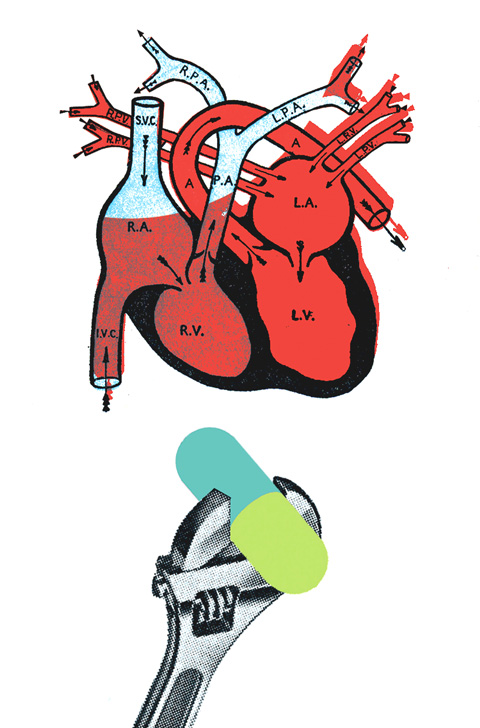As with cholesterol levels, the concept of a normal blood pressure has fallen strikingly as doctors learn what it takes to preserve good health. Decades ago, for example, my brother, Jeff, who had high blood pressure that hovered between 160/80 and 170/90, would have been considered normal.
Lacking good treatments for hypertension, no doctor was concerned when US President Franklin D. Roosevelt’s blood pressure was 170/90 when he was 57 years old. And so the president’s blood pressure rose inexorably over the next six years, and on April 12, 1945, at age 63 and with a pressure of 200/110, he died of a brain hemorrhage caused by severe hypertension.
But in 2000, when Jeff was 54, his cardiologist knew better. Now with excellent treatments, most often used in combination, an elevated pressure can be lowered to normal in most people. His doctor said that, with our family’s medical history of three coronaries on our father’s side occurring at ages 56 and 58, something should be done to protect Jeff’s health.

Jeff’s treatment “evolved” until he was taking a daily three-pill cocktail — Diovan HCT, a combination of a diuretic and angiotensin II receptor blocker; Norvasc, a calcium channel blocker; and Toprol XL, a beta blocker. He also works out on a treadmill several times a week, runs up and down stairs at home and at work all day, and eats a mostly heart-healthy diet, including five to 10 servings of fruits and vegetables a day, whole grain breads, nonfat milk and no added salt.
With his blood pressure now at 106/66, the low end of normal, my brother has thus far escaped a premature coronary death.
Hypertension, once known as the “silent killer,” is now not so silent. Through campaigns urging US doctors to check patients’ pressure at every visit, most cases have been detected. Although treatment has been prescribed for nearly all people known to have blood pressures consistently above 140/90, now called the high end of normal, up to half of patients still have elevated pressures.
Why? Because doctors are not aggressive and creative in treating the problem; because unlike my brother, many patients do not follow doctors’ orders and fail to fill prescriptions or neglect to take medicine daily; and because the rising weight of Americans and the passion for high-salt processed and restaurant-prepared foods have raised the once-normal pressures of many people to levels that experts say should be treated.
A new report from the American Heart Association describes untreated hypertension as now particularly serious among women. Midsection obesity, an important risk factor for hypertension, is found in 79 percent of hypertensive women as against 64 percent of hypertensive men. About a third of hypertensive women have blood pressure controlled at optimal levels, 120/80 or below.
The problem is particularly common among women taking oral contraceptives, whose risk of hypertension is two to three times as high as that of women their age who use some other form of contraception or none at all.
Hypertension is one of the nation’s most common life-threatening diseases, with an overall incidence among adults of nearly 30 percent, a survey of 14,600 people in 2003 and 2004 found. And as many as 66 percent of people 60 and older have elevated pressures that warrant treatment, the survey showed. An increase in blood pressure with age is common only in developed countries, largely a result of a rich and salty diet, overweight and inadequate exercise.
In the US, the high incidence of hypertension and its inadequate treatment has helped level off a decades-long decline in coronary mortality. In addition to heart attacks, untreated or inadequately treated hypertension can cause strokes, congestive heart failure, kidney failure and diabetes.
According to a report last May in The Journal of Clinical Hypertension, myths persist. Last year, a national online survey of 1,245 adults with high blood pressure found that many people still thought that hypertension meant being tense or anxious and that about 30 percent of people thought that it could be cured by losing weight, Marvin Moser of the Hypertension Education Foundation in Scarsdale, New York, and Stanley S. Franklin of the University of California, Irvine, reported.
While weight loss and improvements in diet and exercise habits can indeed help people lower an elevated pressure, “most people can’t adjust their lifestyles enough to normalize their blood pressure,” Moser said in an interview. “Most people need help from medication, notably a diuretic in combination with one or two other drugs. The majority of patients don’t get their pressures to normal without such a combination.”
Doctors have more than 100 drugs to choose from. If one or two do not lower pressure to normal or cause unpleasant side effects, patients should insist on trying others, Moser said. Side effects of blood pressure medications are no longer the problem they once were, the doctor said. “In doses now used, more than 90 percent of people experience very few side effects.”
One problem with a drug-free approach is the difficulty that many patients have in adopting and sticking with a diet and exercise program that can significantly lower their pressure. Data from the latest national nutrition survey, described in the Feb. 11 issue of The Archives of Internal Medicine, said that a diet called DASH that effectively lowered blood pressure was poorly followed by people with hypertension. This diet is rich in fruits, vegetables and low-fat dairy products, a mix that provides excellent sources of fiber, potassium, magnesium and calcium. The diet is most effective if it is low in salt, with a sodium intake of about 1,500 milligrams a day.
The widely publicized value of the DASH diet was demonstrated in a major government-sponsored study published in 1997. But the new report found that in the years since, instead of improving, the dietary quality of people with hypertension has diminished.
Still, as my brother’s case showed, even with a good diet, regular exercise and a healthy weight, most hypertensive patients need medication to achieve an optimal blood pressure. And that includes the elderly, who generally do not respond as well as younger people to blood pressure drugs.
“Studies have shown that even a modest reduction in blood pressure is beneficial to the elderly, reducing their risk of strokes, heart attacks, heart failure and death,” Moser said. “And a new study in the very elderly, people 80 and older, showed that treating hypertension also reduces the overall risk of death.”
In all age groups, “physician inertia is a major problem,” he said, adding, “In 30 percent of patients whose blood pressure remains high despite treatment, nothing is done about changing the medication.”
He urged people whose blood pressure is higher than 140/90 to ask their doctors, “Shouldn’t we be doing something else?”
These are the main categories of medications now used to reduce elevated blood pressure. Two or more types of drugs are typically used in combination to achieve an optimal pressure of 120/80 or less.
Diuretics: These first-line treatments for hypertension wash extra salt or sodium out of the body and allow blood vessels to dilate, which reduces blood pressure. They include Esidrix, Hydrodiuril and Zaroxolyn.
ACE inhibitors: Drugs like Aceon, Lotensin, Monopril and Vasotec act by preventing the production of the chemical acetylcholine esterase, which causes blood vessels to constrict.
ARBs: Also known by their full name, angiotensin receptor blockers, these drugs affect the same chemical as ACE inhibitors but at a different location. They include Diovan, Benicar and Avapro.
Calcium channel blockers: Drugs like Norvasc, Procardia XL and DynaCirc CR help dilate blood vessels by preventing calcium from entering blood vessel walls or heart muscle.
Beta blockers: Lopressor, Tenormin and Toprol XL reduce the effects of adrenaline. They reduce the work of the heart by slowing the heart rate and reducing its force when it contracts, thus lowering blood pressure.

May 26 to June 1 When the Qing Dynasty first took control over many parts of Taiwan in 1684, it roughly continued the Kingdom of Tungning’s administrative borders (see below), setting up one prefecture and three counties. The actual area of control covered today’s Chiayi, Tainan and Kaohsiung. The administrative center was in Taiwan Prefecture, in today’s Tainan. But as Han settlement expanded and due to rebellions and other international incidents, the administrative units became more complex. By the time Taiwan became a province of the Qing in 1887, there were three prefectures, eleven counties, three subprefectures and one directly-administered prefecture, with

It’s an enormous dome of colorful glass, something between the Sistine Chapel and a Marc Chagall fresco. And yet, it’s just a subway station. Formosa Boulevard is the heart of Kaohsiung’s mass transit system. In metro terms, it’s modest: the only transfer station in a network with just two lines. But it’s a landmark nonetheless: a civic space that serves as much more than a point of transit. On a hot Sunday, the corridors and vast halls are filled with a market selling everything from second-hand clothes to toys and house decorations. It’s just one of the many events the station hosts,

Through art and storytelling, La Benida Hui empowers children to become environmental heroes, using everything from SpongeBob to microorganisms to reimagine their relationship with nature. “I tell the students that they have superpowers. It needs to be emphasized that their choices can make a difference,” says Hui, an environmental artist and education specialist. For her second year as Badou Elementary’s artist in residence, Hui leads creative lessons on environmental protection, where students reflect on their relationship with nature and transform beach waste into artworks. Standing in lush green hills overlooking the ocean with land extending into the intertidal zone, the school in Keelung

Taiwan Power Co (Taipower, 台電) and the New Taipei City Government in May last year agreed to allow the activation of a spent fuel storage facility for the Jinshan Nuclear Power Plant in Shihmen District (石門). The deal ended eleven years of legal wrangling. According to the Taipower announcement, the city government engaged in repeated delays, failing to approve water and soil conservation plans. Taipower said at the time that plans for another dry storage facility for the Guosheng Nuclear Power Plant in New Taipei City’s Wanli District (萬里) remained stuck in legal limbo. Later that year an agreement was reached